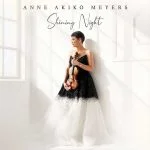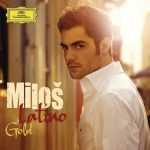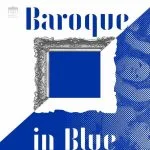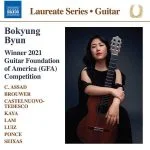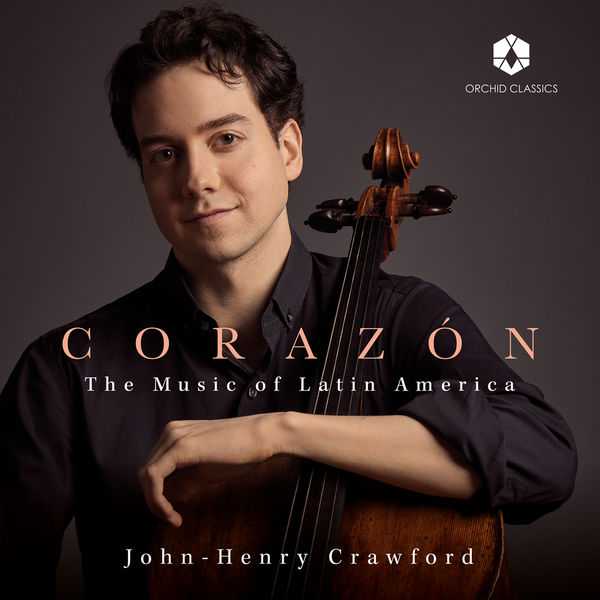

Composer: Leo Brouwer, Egberto Gismonti, Carlos Guastavino, Astor Piazzólla, Manuel Maria Ponce, Heitor Villa-Lobos
Performer: John-Henry Crawford, Victor Santiago Asuncion, Jiji
Format: FLAC (tracks)
Label: Orchid
Catalogue: ORC100198
Release: 2022
Size: 1.18 GB
Recovery: +3%
Scan: yes
01. Brouwer: Canción de Cuna
02. Villa-Lobos: O canto do cisne negro, W122
03. Guastavino: Pampamapa
Ponce: Canciones populares mexicanas
04. No. 5, Por tí mi corazón (Arr. for Cello & Piano)
05. Gismonti: Agua e Vinho
Ponce, M: Canciones Populares Mexicanas
06. No. 2, Estrellita (Arr. Jiji & J. Heifetz for Cello & Guitar)
07. Piazzólla: Le Grand Tango
Villa-Lobos: Pequena Suíte, W064
08. V. Melodia
09. Villa-Lobos: Ondulando (Rippling)
Ponce: Cello Sonata
10. I. Allegro selvaggio
11. II. Allegro
12. III. Arietta
13. IV. Allegro burlesco
14. Piazzólla: Oblivion
According to the Spanish guitarist Andrés Segovia, Mexican musician Manuel Ponce (1882-1948) was the most significant composer in the modern revival of guitar music. Ponce’s body of guitar music is almost unparalleled in the 20th century, rivalled only by that of Heitor Villa-Lobos and Leo Brouwer. He was Mexico’s first nationalist composer, but he also drew upon Spanish and Cuban styles, as well as European and American impressionism; his music ranges from romanticism to bitonality and atonality. Villa-Lobos met Ponce in Paris in the 1920s and later recalled: “I remember that I asked him at that time if the composers of his country were as yet taking an interest in native music, as I had been doing since 1912, and he answered that he himself had been working in that direction. It gave me great joy to learn that in that distant part of my continent there was another artist who was arming himself with the resources of the folklore of his people in the struggle for the future musical independence of his country”.
With its irresistibly charming melody, Ponce’s most famous work is his song Estrellita (1912) – the first of two Canciones mexicanas – heard here in an arrangement for cello and guitar. In a similar vein, Por ti mi corazón (1925) is the second of Ponce’s Canciones populares mexicanas.
The Sonata for Cello and Piano in G minor (1922), dedicated to Uruguayan cellist Oscar Nicastro, is a fine example of Ponce’s Latin American modernism. The work opens with a stormy, surging Allegro selvaggio, the “wild” momentum of the opening theme softening into romantic lyricism with a long-breathed cello melody. Contrasts between these two characters continue throughout the movement, explored via compelling dialogue between the cello and piano. The second movement bears the unusual marking Allegro alla maniera d’uno studio, and opens with jangling piano and pizzicato cello, gaining in energy as the cello, now arco, articulates a vigorous theme. The movement reaches what feels like an ending before Ponce introduces a much slower section, the cello in its lower register and in contemplative mood, before the opening material is reprised. An Arietta follows, explicitly linking the cello with the human voice, its sonorous utterances coloured by the piano’s wealth of shimmering textures. Two arresting piano chords usher in the “burlesque” finale, which marches forwards in a manner more purposeful than playful, but the slower, ardent cello writing that has cropped up throughout the sonata is recalled once more before the almost abrupt surprise of the final bars.
Leo Brouwer (born 1939) has been at the forefront of Cuban musical life for decades. Following his early guitar studies, he started composing, self-taught, before attending The Juilliard School. Brouwer helped to launch the avant-garde scene in Cuba in the 1960s and has conducted numerous orchestras there and internationally. His output may be divided into three main phases: essentially nationalistic (ca. 1955-62), avant-garde (1962-67), and then a mellowing of that modernism, especially after the 1980s, when what he described as a “new simplicity” emerged. He said of his musical inspiration: “I use any form to help me find musical forms: that of a leaf, of a tree or geometric symbolisms. All these are also musical forms; despite the fact that my works appear very structured, what interests me is sound”. Heard here in an arrangement for cello and guitar, Brouwer’s Canción de cuna from Dos temas populares Cubanos (1978) is sometimes known as the Afro-Cuban Lullaby and is based on the Drume negrita by Cuban composer and pianist Eliseo Grenet (1893-1950).
Heitor Villa-Lobos (1887-1959) was the 20th century’s most significant Brazilian composer of art music, combining European models with Brazilian styles. Villa-Lobos received his earliest musical education from his father, Raúl Villa-Lobos, who taught his son to play the cello – which became the composer’s favourite instrument. Villa-Lobos became fascinated by the popular music of Rio de Janeiro, teaching himself the guitar in order to participate in the city’s musical life. After dropping out of medical school, the teenage Villa-Lobos earned money playing the cello in hotels, the Teatro Recreio and the Odeon cinema.
The Pequeña Suite of 1913 is Villa-Lobos’s earliest published work for cello and piano and reflects his love of J. S. Bach, which developed at an early age thanks to his aunt. The Suite was premiered in the summer of 1919 at the Salão Nobre in Rio de Janeiro, with Villa-Lobos playing the cello and Roberto Soriano at the piano. The composer’s flair for writing beautiful melodies is demonstrated in the Melodia, the fifth of six movements. O canto do cisne negro or Chant du cygnet noir (1917) was adapted by Villa-Lobos from his 1916 symphonic poem Naufrágio de Kleônicos. The piece opens with a rippling piano texture, over which the cello plays a seamless melody punctuated by exotic inflections. Rippling or Ondulando (1914) was originally written for solo piano; John-Henry Crawford’s arrangement brings out the work’s captivating melodic line.
Carlos Guastavino (1912-2000) was an Argentine composer and pianist who reached musical maturity during the 1940s, when Latin American national feeling was high (events such as the Mexican Revolution of 1910-20 were still fresh in the memory, and in Argentina this was the era of Juan and Eva Perón). Guastavino’s output almost always possessed a national flavour, reflecting his love of Argentina and its wildlife especially and embracing folk cultures such as the Gauchesco (South American cowboys) and Criollo (people of Spanish descent born in the colonies). He favoured tonal music and traditional forms, raising objections to aspects of modern music. From the 12 Canciones populares (1968) we hear No. 6, “Pampamapa”, originally a song to words by Hamlet Lima Quintana that are at once poignant and defiant: “On the trail, my land, so sleepless. / I will give you my dreams, give me your calmness”.
Egberto Gismonti (born 1947) is a Brazilian composer who studied at the Nova Friburgo Conservatory and with Nadia Boulanger in Paris. Influences have included music reflecting his own Arabic and Italian heritage, choro and bossa nova, Brazilian Indian themes, jazz, and the music of Villa-Lobos and Stravinsky; like Villa-Lobos, Gismonti taught himself to play the guitar. Arranged for cello and guitar by John-Henry Crawford, Água e vinho (1972) is a hypnotically beautiful song from Gismonti’s album of the same name, originally to lyrics by Geraldo E. Carneiro.
Astor Piazzolla (1921-1992) was born in Buenos Aires before moving with his family to New York in 1924, escaping Argentina’s economic crisis to the cultural melting pot of Greenwich Village, where Astor’s father, Vincent, ran a barber’s shop. Vincent gave Astor a present for his eighth birthday: a bandonéon that he’d found in a pawn shop. “He brought it wrapped in a box, and I was happy, believing that it was the skates that I had asked for many times. That was deceptive, however. In place of the skates I encountered an apparatus that I had never seen in my life. Papa sat himself on a chair, placed the thing between my arms, and said to me: “Astor, this is the instrument of the tango, I want you to learn to play it. My first reaction was to complain. The tango was the music that he listened to almost every night when he returned from work, and which I did not like”.
At first more interested in listening to Bach and jazz than playing the instrument, Astor started practising to please his father, but soon became proficient. Piazzolla moved back to Buenos Aires in 1937, studying with Ginastera. In 1954, a symphony he’d written for the Buenos Aires Philharmonic won him a scholarship to study in Paris with Nadia Boulanger, who recognised where his real passions lay; she urged him to focus on the tango rather than on purely classical forms, observing: “Here you have the real Piazzolla; Astor, be true to him”. This period of study lasted for about 18 months but had such a profound impact that Piazzolla said the growth he’d experienced felt more like “eighteen years”. Back in Buenos Aires, he developed the “nuevo tango” style, blending chromaticism, jazz, fugal textures, and dissonance. Not everyone was convinced: in the 1950s, when Piazzolla was conducting, a member of the orchestra sniffed, “I assume you are nothing to do with this Piazzolla who plays tangos”. Piazzolla later argued: “Those classical musicians are like that – they are from Buenos Aires, Argentineans, and yet it seems that the tango shames them. That is an old division that exists between the classical and the popular. The musicians of the Colón [the Buenos Aires opera house] look at those of the tango as if they were trash. And it should not be so. It is a big lie”.
Le Grand Tango dates from 1982, by which time Piazzolla’s music was internationally acclaimed. In a single movement for cello and piano and dedicated to Mstislav Rostropovich, this passionate piece embodies the “nuevo tango” style, combining tango rhythms with jazz syncopation. Dating from the same year, Oblivion is one of Piazzolla’s most famous works, its mournful melody lending itself perfectly to the plangent tone of the cello.
